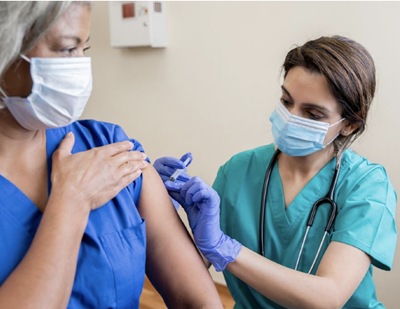‘Not a drill’: COVID vaccination efforts boosted by pharmacists in training
 Fletcher Tove, Buncombe County HHS public health emergency preparedness director |
 Greene Shepherd, PharmD, UNC Eshelman School of Pharmacy PACE Division vice chair |
 Jennifer Mullendore, MD, Buncombe County HHS medical director |
 Stephanie Kiser, RPh, Eshelman School of Pharmacy rural health director |
 Monica Dillingham, PharmD, BCACP, CPP, Buncombe County HHS pharmacist |
The pandemic has put intense pressure on communities to find public health solutions, combining people and resources for emergency response and vaccine distribution and education efforts. In North Carolina, students and faculty from UNC Eshelman School of Pharmacy-Asheville campus joined forces with Buncombe County Health and Human Services (HHS) to train a volunteer workforce for the COVID-19 vaccination effort.
The Eshelman School of Pharmacy started its collaboration with Buncombe County HHS five years ago when they implemented annual disaster preparedness training events for pharmacy students. “Our collaboration with our local HHS focused on helping increase their trained volunteer workforce in the event of a disaster where point of dispensing (POD) sites were needed for mass distribution of vaccines or medication. Little did we know that these practice drills would become a reality during the pandemic,” says Stephanie Kiser, RPh, Eshelman School of Pharmacy rural health director.
“We launched the training events with the pharmacy students in 2017 and added more complexity every year,” says Fletcher Tove, Buncombe County HHS public health emergency preparedness director. “The students practiced drills to prepare for a range of disaster scenarios, including anthrax exposure, pandemic influenza, meningitis, and measles. We’re continuing to expand the partners involved through collaboration with local stakeholders and school systems.”
“These training events mimic a public health emergency, whether it’s an outbreak or exposure. This allows us to set up the mobile POD and practice seeing how many people we can get treated or vaccinated in a timeframe,” says Monica Dillingham, PharmD, BCACP, CPP, Buncombe County HHS pharmacist.
Practice makes perfect
“In January of 2020, we practiced drills for a mass immunization event and how to get people through in an efficient and safe manner. Then COVID-19 happened, and it became clear that this was not a drill,” says Greene Shepherd, PharmD, UNC Eshelman School of Pharmacy PACE Division vice chair
Students were eager to get involved, and it was easy to plug students into the experience. They already had experience and immediate familiarity with the workflow for mass vaccination, from check-in and providing education to administering vaccines and follow-up.
-Stephanie Kiser
Students put their training into practice in various phases throughout 2020 and 2021. “Students were trained and ready to volunteer at COVID-19 testing sites in the summer and fall,” says Jennifer Mullendore, MD, Buncombe County HHS medical director. “Students assisted with nasal swabbing and helped fill out paperwork and provide education to people coming to our community-based testing events.”
When the county began ramping up flu vaccination clinics last fall, this provided an opportunity to align the staff, volunteers, and resources needed for mass immunization events and make inroads with communities that may be hesitant to get vaccinations.
When COVID-19 vaccines became available in December, POD sites were designed as mass distribution sites. “Students were eager to get involved, and it was easy to plug students into the experience. They already had experience and immediate familiarity with the workflow for mass vaccination, from check-in and providing education to administering vaccines and follow-up,” Kiser says.
Oversight for a volunteer workforce
Meeting regulatory requirements for students to join the workforce for Buncombe County HHS made it possible to bring students in quickly for the vaccination effort. “Through a practical memorandum of understanding, we have been able to meet regulatory requirements that allow our trained volunteers to become an additional workforce for our HHS department in Buncombe County,” Kiser says.
The first step was to ensure that the students had been trained and certified to immunize. “This is standard pharmacy curriculum that students take in the first two months of school,” Shepherd explains. “Students also completed just-in-time training modules the CDC provides on mixing vaccine properly and techniques for administering new vaccines.”
On the regulatory side, faculty worked with state board of pharmacy staff to clarify the level of supervision students needed. “Whenever a student is working with the county, we need to have a supervising pharmacist available to them. This allowed faculty to get involved and help out alongside students in the community,” Shepherd says.
Benefits of collaboration
Forming community partnerships makes it possible to achieve important goals while creating meaningful experiences for those involved. The disaster preparedness collaboration in Buncombe County continues to provide a range of benefits for students, public health responders, and the community.
Students benefited from hands-on experience in public health preparedness and response, helping them become well-rounded professional pharmacists. “The students are exuberant and excited to put their education into practice. They worked hard putting everything they learned into practice and contributing to the health of our community,” Mullendore says.
“An opportunity like this also ignites a spark in students, inspiring them to pursue paths and internships leading to more exposure to public health and disaster preparedness,” Kiser adds.
Buncombe County HHS accelerated its community vaccination efforts with help of a trained volunteer workforce. “The student volunteers working with our teams were an efficient part of the solution. There’s a cost reduction associated with volunteer response, which provides some relief to public health workers who have been under pressure and dealing with burnout during the pandemic,” Tove says.
“It was a relief of some of the heavy burden placed on public health and emergency services. The student Summer 2021 5 volunteers helped us deliver vaccines quickly and see more people, which protects our community,” Mullendore says.
Members of the community benefitted from a more robust public health response made possible by a volunteer workforce and the collaboration that helped create a smooth experience.
“Through this local partnership in Buncombe County, hundreds of pharmacy students have been involved over the last four years and will continue to be important drivers of public health. Many of these students are now practicing pharmacists across the region and state and well-prepared to reach out to their own communities to respond in a public health crisis,” Tove says.
Role of pharmacy in vaccine outreach
Pharmacists and pharmacies are well positioned to respond to a public health crisis and play a role in prevention, education, testing, and vaccination. Pharmacists in rural and small communities can have significant impact by taking an active role in public health and disaster response.
“Outreach efforts need to be more nuanced and targeted in rural communities. People may have questions or worry about the costs of getting vaccinated. They may not be able to travel to a vaccination site many miles away. In times like this, the local pharmacy can be the trusted resource and help connect people with information,” Dillingham says.
The local pharmacy is often the first place people go with questions about their health. “People visit their pharmacy an average of 30 times a year as compared to seeing their primary care physician an average of four to five times a year,” Kiser says. “It becomes even more important in a public health crisis, because people need to see faces they recognize when trying to understand health risks and making medical decisions.”
Pharmacists also have an important role in partnering with primary care to improve the health of communities. “Pharmacists are trained to be very skilled at communicating about risk,” Shepherd says. “Think about medication safety — the side effects of drugs and lots of scary-sounding stuff. Pharmacists learn how to talk about balancing the risks and benefits of medication and vaccines.”
Pharmacies make health care more accessible in rural and remote areas and can serve as a connector for people who have limited access to health care. “There’s a lot of work to be done on a local level, across the state, and country on how to maximize the skill sets and the reach of pharmacies and pharmacists as public health professionals,” Mullendore says.
Working together for public health

Making connections between higher education and public health can help strengthen community response by leveraging a network of student volunteers. “This model of collaboration for disaster preparedness could be replicated across rural and small communities wherever there are pharmacy schools, nursing schools, or other health professions schools,” Kiser says.
Buncombe County is unique because it crosses over between urban and rural and has a larger public health department compared to neighboring communities. In rural settings, public health programs tend to have fewer resources and staff and an even greater need for volunteers in times of crisis.
Pharmacists in smaller communities may have opportunities to serve in leadership roles, giving them a voice in public health initiatives and planning. “We hope students will take these experiences with them and continue to contribute to public health efforts wherever they land in the future,” Mullendore says.
The strength of rural comes from the close relationships people have and the ability to come together to solve problems. “We’ve learned the value of relationships when we need to quickly implement emergency plans,” Shepherd says. It starts by reaching out to local emergency planners and health departments and getting involved.
